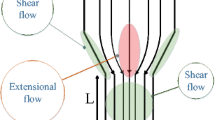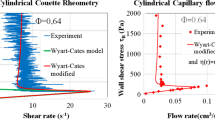Abstract
The research and modeling of the connection of polymer viscosity and the present pressure level have brought forth a variety of, often contradictory, results. While different machinery setups are used resulting in less comparison of the studies, a combined analytical and experimental approach to apply end corrections at correct pressure levels has not been presented yet. In this work, the effect of pressure on end corrections in die flow is assessed with a combination of a pressure chamber and an orifice die, and applied to capillary rheometry measurements at different pressure levels. The pressure dependence of the end corrections has been found to show good correlations with an applied modified Power-Law model. By comparing the results to regular end corrections, the error in computing the viscosity has been found to be largely independent of the shear-rate. Neglecting the influence of pressure on end corrections yields 0–12 % too high viscosities, depending on the average die pressure.








Similar content being viewed by others
References
Ansari M, Alabbas A, Hatzikiriakos SG, Mitsoulis E (2010) Entry flow of polyethylene melts in tapered dies. Int Polym Process 25(4):287–296
Ansari M, Zisis T, Hatzikiriakos SG, Mitsoulis E (2012) Capillary flow of low-density polyethylene. Polym Eng Sci 52(3):649–662
Bagley EB (1956) End corrections in the capillary flow of polyethylene. J Appl Phys 28(5):624–627
Barus C (1893) Isothermals, isopiestics and isometrics relative to viscosity. Am J Sci 45:87–96
Binding DM, Couch MA, Walters K (1998) The pressure dependence of the shear and elongational properties of polymer melts. J Non-Newtonian Fluid Mech 79(2-3):137–155
Chakravorty S, Rides M, Allen CRG, Brown CS (1996) Polymer melt viscosity increases under pressure: simple new measurement method. Plastics and Rubber Processing and Applications 25:260–261
Eisenschitz R, Rabinowitsch B, Weissenberg K (1929) Zur Analyse des formänderungswiderstandes. Mitteilungen der deutschen materialprüfungsanstalten, Sonderheft IX: Arbeiten aus dem Kaiser-Wilhelm-Institut für Metallforschung und dem Staatlichen Materialprüfungsamt zu Berlin-Dahlem, pp 91–94
Hay G, Mackay ME, Awati KM, Park Y (1999) Pressure and temperature effects inside slit rheometry. J Rheol 43:1099–1116
Hirai N, Eyring H (1959) Bulk viscosity of polymeric s. J Polym Sci 37:51–70
Kadijk SE, Van den Brule BHAA (1994) On the pressure dependency of the viscosity of molten polymers. Polym Eng Sci 34(20):1535–1546
Karl VH (1978) Über die druckabhängigkeit der viskoelastischen und physikalisch-chemischen Eigenschaften von Polymeren, 8: Die viskosität von Polyethylen bis 5000 bar. Die Angewandte Molekulare Chemie 79:11–19
Laun HM (1983) Polymer melt rheology with a slit die. Rheol Acta 22:171–185
Liang J-Z (2001) Pressure effect of viscosity for polymer fluids in die flow. Polymer 42:3709–3712
Mackley MR, Hassell DG (2011) The multipass rheometer a review. J Non-Newtonian Fluid Mech 166:421–456
Mitsoulis E, Hatzikiriakos S G (2003) Bagley correction: the effect of contraction angle and its prediction. Rheol Acta 42:309–320
Mooney M (1931) Explicit formulas for slip and fluidity. J Rheol 2(2):210–222
Moldenaers P, Vermant J, Mewis J, Heyndrickx I (1996) Origin of nonlinearities in the Bagley plots of thermotropic copolyesters. J Rheol 40:203–219
Münstedt H, Schwarzl FR (2014) Deformation and flow of polymeric materials. Springer, Berl. in Heidelberg
Nogales A, Hsiao BS, Somani RH, Srinivas S, Tsou AH, Balta-Calleja FJ, Ezquerra TA (2001) Shear-induced crystallization of isotactic polypropylene with different molecular weight distributions: in situ small- and wide-angle X-ray scattering studies. Polymer 42(12):5247–5256
Osswald TA, Menges G (2012) Materials science of polymers for engineers 3 rd edition. Carl Hanser, Munich
Ostwald W (1929) Ueber die rechnerische Darstellung des Strukturgebietes der Viskositaet. Kolloid-Zeitschrift 47(2):176–187
Pogodina NV, Victor PL, Srinivas S, Winter HH (2001) Rheology and structure of isotactic polypropylene near the gel point: quiescent and shear-induced crystallization. Polymer 42(21):9031– 9043
Rudolph N, Osswald TA (2014) Polymer rheology: fundamentals and applications. Carl Hanser, Munich
Tapadia PS, Joshi YM, Lele AK, Mashelkar RA (2000) Influence of stereoregularity on the wall slip phenomenon. Macromolecules 33:250–252
VDI e.V. (2013) VDI-Wärmeatlas. 11th edition. Springer Vieweg, Berlin Heidelberg
Author information
Authors and Affiliations
Corresponding author
Rights and permissions
About this article
Cite this article
Mattner, T., Drummer, D. Influence of pressure on end corrections in capillary rheometry. Rheol Acta 55, 823–832 (2016). https://doi.org/10.1007/s00397-016-0958-z
Received:
Revised:
Accepted:
Published:
Issue Date:
DOI: https://doi.org/10.1007/s00397-016-0958-z




